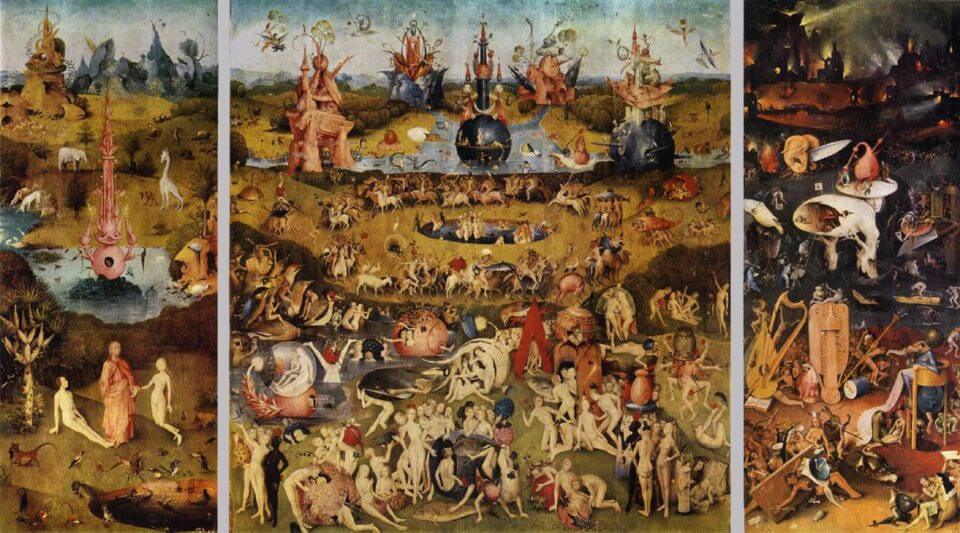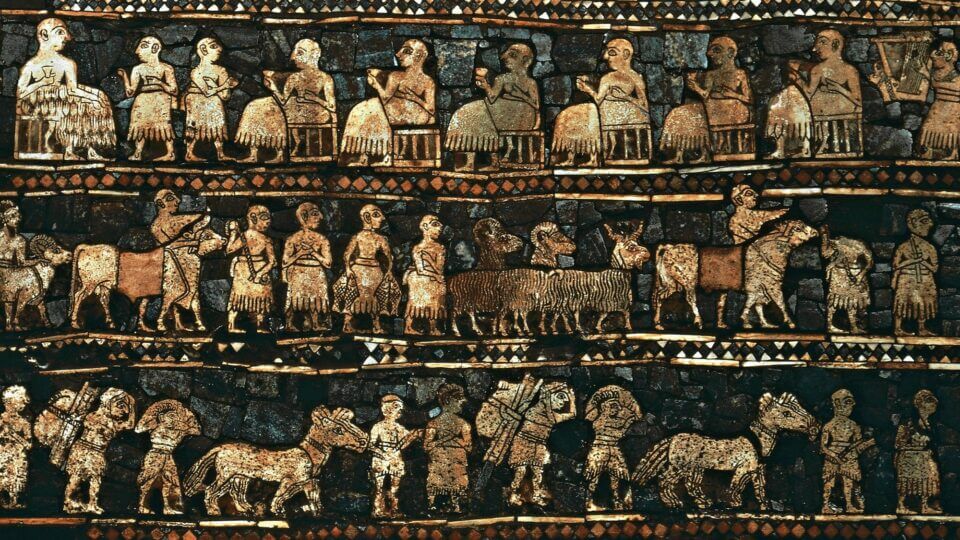
“Bart Ehrman, ever loyal to his engaging style, approaches this topic in Heaven and Hell: A History of the Afterlife. As expected, he delivers the goods, covering religious texts from the Epic of Gilgamesh to the writings of Augustine.”
The most common argument against religion is that it is a come-on. While a laborer does the back-breaking work out in the field, a priest is eating grapes in the temple. When harvest time comes, this laborer give tithes to that priest. When he realizes that he is being exploited and begins to think of a revolution, the priest tells him that the more he pays now, the better off he will be in the afterlife. Nobody has any clue about what heaven or hell might be like (if such places even exist), but somehow, one believes the priest speaks for God (if he even exists at all). In the end, one is persuaded to just shut up and get back to work.
The likes of Voltaire and Marx repeated this argument ad nauseam. And, indeed, it is not a bad one. St Peter’s basilica in Rome was built with funds coming from people who heard those such as Johann Tetzel preach, “as soon as a coin in the coffer rings, another soul from purgatory springs.” When televangelists say similar things, one cannot help but wonder if religion is basically a scam—and heaven and hell are the fronts for this ponzi scheme.
But, matters are more complicated. As it turns out, at least in Western civilization, ideas about the afterlife are surprisingly recent, and they have been refashioned multiple times. Bart Ehrman, ever loyal to his engaging style, approaches this topic in Heaven and Hell: A History of the Afterlife. As expected, he delivers the goods, covering religious texts from the Epic of Gilgamesh to the writings of Augustine. As with any of Ehrman’s books, there is a masterful combination of erudition and clear prose. Yet, I was a bit disappointed to find no discussion of the ancient Egyptians, especially considering that the weighing of the heart is one of the first afterlife images that we know of, and it, surely, must have had some influence on posterior conceptions of the Final Judgment.
Be that as it may, Ehrman is quick to remind us that religions have not always focused on the afterlife. There certainly was a fear of death and a desire for immortality, as in the Epic of Gilgamesh. However, in that famous poem, the hero fails to secure immortality. Thus, the poem serves as reminder that we will all die, and that is that. The Mesopotamians were certainly afraid of death, but they were not in the business of wishful thinking.
Ehrman, then, turns to the Greeks. By the time the Iliad and the Odyssey were written, the Greeks believed that after death, souls of common folk go to Hades, the gloomy underworld. Not much of excitement goes on there, and when Odysseus visits, he encounters people who are not terribly happy about being there. As in the Epic of Gilgamesh, readers of the Homeric works held onto the fear of death because the “other side” did not look promising. In fact, it made little difference if you were good or bad; everybody will ultimately end up in the same gloomy place.
By the time Socrates began philosophizing, refined Greeks were thinking about the afterlife differently. Death was now seen as some sort of liberation, to the extent that—being separated from the body—the soul could engage in pure intellectual activity. As such, Greek philosophers brought some joy by assuring us that death is not to be feared. Other philosophers, such as Epicurus, argued that even if there is no afterlife, there is nothing to fear because—once you are dead—you feel nothing. And, if you are not concerned about the things that happened before you were born, why should you be concerned about the things that will happen after you die? Powerful logic indeed. In fact, I find it extremely difficult to refute Epicurus’ argument, but that in no way takes away my fear of death. I suppose this is yet another instance in which emotions override rationality, and there is little one can do about it.
We do not know much about what common Greeks and Romans believed, but it does appear that the afterlife was not of great concern, to the point that graves commonly had this inscription: non fui, fui, non sum, non curo, “I was not; I was; I am not; I care not.”
Interestingly, Ehrman argues that the philosophical activity of Greeks brought more ethical awareness to the world. As such, by the time Virgil composed the Aeneid, the afterlife had more of a moral component. Very much as Odysseus, Aeneas visits the underworld. However, this time, there is some sort of judgment with rewards and punishments, so fate in the afterlife has a degree of correspondence with the moral character of people. Ehrman, though, is cautious in telling us that the religious views of poets was not necessarily the same as those of the common people. We do not know much about what common Greeks and Romans believed, but it does appear that the afterlife was not of great concern, to the point that graves commonly had this inscription: non fui, fui, non sum, non curo, “I was not; I was; I am not; I care not.”
That is the pagan world. But, what about the Bible? Ehrman is quick to tell us that—contrary to the common expectation of modern Christians—in the Hebrew Bible (the Old Testament, for Christians), there is almost nothing about the afterlife. Apparently, the belief was that the dead went to Sheol, a place akin to the Greek Hades. Ehrman makes the interesting argument that when Hebrew poets talked about Sheol, they only meant the grave—not an actual afterlife. Surprisingly, the Hebrews were not all that terrified of going down to Sheol, to the point that Job dies “old and contented.” Again, Ehrman is quick to remind us that we cannot really be sure about what common people believed. Indeed, there may be hints about belief in some forms of post-mortem existence, as in the story of the Witch of Endor summoning the spirit of Samuel. Yet, by and large, the Hebrews cared little about the afterlife.
What the Hebrews did care for, however, was the restoration of Israel as a nation, after many humiliations by enemies. And, this hope of restoration was expressed in imagery (most notably in the books of Isaiah and Ezekiel) that current Christians may erroneously think refers to the idea of resurrection (most famously, Ezekiel’s vision of dry bones being fleshed). But, once again, Ehrman dispels the myth and informs us that such images are not about the afterlife. They are about national renewal.
The Hebrew prophets were not concerned with the afterlife because they believed that God settled the scores in this life. But, the harsh reality eventually kicked in, and Biblical authors realized that many righteous people suffer, and many wicked people thrive. So, the idea that the scores would have to be settled—if not in this life, then in the hereafter—began to appear. This especially became the case when the ideology of martyrdom became prominent. By the time Israel was feeling the heat of Seleucid (a Hellenist dynasty) oppression, a new kind of apocalyptic hope appeared. God would intervene to drive out the oppressors, and, in so doing, he would punish the wicked and would reward the virtuous, especially those who had died resisting oppression. In the book of Daniel (written during this period), resurrection now played a role in this scheme of divine justice.
Yet interestingly, as Ehrman tells it, there was no hell as such. The wicked are simply annihilated. Only the righteous are resurrected, to everlasting joy. Ehrman does not mention it, but this is the view of Seventh Day Adventists, a relatively small denomination, mostly inconsequential in the larger scheme of Christianity. Yet, Ehrman insists that this annihilationist view is what Jesus, himself, believed.
I am now beginning to be persuaded by Ehrman and have come to think that perhaps Jesus did not have in mind the torture chambers of Dante’s Inferno.
I was taken aback by this argument. Didn’t Jesus talk about Gehenna (traditionally translated as “hell” in most Bibles), a place of everlasting fire? Yes, says Ehrman. But, the fire burns only to annihilate the wicked, not to torture them. In Ehrman’s words, “[Jesus] does not contrast ‘eternal torture’ with ‘eternal reward’ or ‘eternal misery’ with ‘eternal happiness.’ He contrasts the eternal punishment of the wicked with eternal life. What is the opposite of life? It is not torture or misery. It is death.” I am now beginning to be persuaded by Ehrman and have come to think that perhaps Jesus did not have in mind the torture chambers of Dante’s Inferno.
Ehrman has made a name in scholarship by arguing that Jesus was an apocalypticist. And, as such, Jesus believed that resurrection would take place at the end of time which, in his view, was just around the corner. But, given that the apocalypse did not seem to come, there was yet another change in conceptions of the afterlife. People did not want to wait until the end of time to be rewarded for their good lives. So, some texts began to conceive of God presiding over a judgment immediately after a person’s death. This would not be resurrection (as the body stayed in the grave), but the soul of the righteous would be rewarded with some sort of heavenly existence. This is the kind of view advanced in 4 Maccabees; Ehrman notes the irony that, though its author was decidedly anti-Greek in celebrating the martyrdom of Jews who refused to surrender to Greek imperialism, the text ultimately upheld the very Greek concept of the immortality of the soul, which until that time, was largely foreign to Jews.
According to Ehrman, Paul was also an annihilationist. Naturally then, there is no mention of hellfire in his letters. And, in the early stages of his career, he was also an ardent apocalypticist, expecting Jesus’ return. At first, Paul believed he would be alive when this event would happen, and those who had died previously would be resurrected (again, only those who would be saved). But, in Ehrman’s telling, given that Christ had not yet returned, by the time Paul wrote 2 Corinthians and Philippians, he began to have doubts and anticipated that perhaps he would die before Christ’s return. So, he envisioned an interim state in which there would be a (brief) incorporeal heavenly existence in heaven.
By the time the gospel of Luke was written, the idea of hell finally appeared in the New Testament. Ehrman has famously written many books discerning which of Jesus’ words are authentic. Ehrman thinks that the parable of Lazarus and the rich man, solely narrated in Luke, was never told by Jesus. Yet, that parable develops two ideas that are now mainstream in Christianity: There is a judgment immediately after death, and there is a hell. In Ehrman’s view, this reflects a de-apocalypticizing of Jesus’ message by the evangelists, in light of the fact that the apocalypse was not coming as originally expected. The gospel of John tones down apocalyptic expectations even further: In that gospel, it seems as if eternal life is already here, as some sort of spiritual transformation.
Somewhat surprisingly, Ehrman thinks that the parable of Lazarus is the only real reference to hell in the entire Bible. The book of Revelation certainly makes much of a lake of fire for sinners, but Ehrman insists that this only refers to annihilation of sinners, not everlasting punishment. In his words, “even though later Christians transformed the symbolic ‘lake of fire’ into a literal description of the fire pits of hell, where people would burn forever…John [of Patmos] agreed with his Lord Jesus and his forerunner Paul. For sinners, death is the end of the story.” By contrast, the famous descriptions of the New Jerusalem in the book of Revelation, though not to be taken literally, do reaffirm the idea that the righteous will be resurrected to a utopian place in the eternal presence of God. (All the while, Ehrman amusingly does note some inconsistencies in this place, such as the existence of unclean things.)
How, then, did the scant reference to hell in the New Testament, morph into the full-blown doctrine that most Christians adhere to today? Ehrman thinks that the answer lies in martyrdom. Although he admits that accounts of Christian persecution are mostly exaggerated, he believes that perceived persecution was strong enough so as to motivate an eagerness for vindication. By the second century, annihilation of sinners was not satisfying enough; Christian authors wanted a bigger punishment. So, by that time, authors such as Tertullian were already delighting in the prospect of contemplating sinners being tortured for all eternity.
Yet, also by that time, Christians were beginning to be ridiculed by philosophers, who poked holes into their strange doctrines regarding resurrection. These are the sorts of questions that are still sensibly asked today (How can resurrection happen when a cannibal eats someone else?; Will people with deformities be resurrected with those defects, too?, etc.). Ehrman reviews how Christian authors such as Athenagoras and Augustine tried to reply. Needless to say, those responses are far from satisfactory, yet, somehow, most contemporary Christians accept them.
Ehrman also considers the way some early theologians began to question if the afterlife could be a simple heaven/hell binary. Perhaps some people had minor sins, and they could be purged before entering heaven. Although the doctrine of purgatory was only formalized in the 12th century, Ehrman finds important antecedents of it in 2nd century texts such as the Acts of Thecla. Apparently, this opened yet another can of worms: If some sins could be purged with temporary sufferings, why couldn’t all sins be purged and, consequently, everyone would ultimately be saved? Ehrman relates how one Christian author in the 3rd century, Origen, came to believe that, indeed, all would be saved (even Satan). And, even more surprisingly, Origen believed that in this purging process, sinners would be sent to Earth once again; he, thus, embraced the doctrine of reincarnation.
Ehrman is a historian of religion, so he says very little about which of these views he sympathizes with. Only in the epilogue does he declare his most explicit sympathies for Epicurean philosophy. Ehrman thinks there is no afterlife, but he is not really troubled by it, precisely on the basis of the Epicurean argument: There is nothing to worry about, because—in death—one does not feel anything. I might add that, even if there is an afterlife, this prospect is replete with (possibly insurmountable) conceptual problems related to personal identity. Ever since Augustine, Christian authors have failed to provide satisfying solutions.
Ultimately, the fact that Ehrman is not committed to any religious view works to his advantage as a historian. All theologians want a piece of the Jesus pie, so, very frequently, they play ventriloquist by projecting onto the historical Jesus their own views. Most of these theologians are eager to uphold the doctrine of hell, so they paint a Jesus who speaks of Gehenna as a place of everlasting punishment. Others, such as David Bentley Hart, seem embarrassed by the conceptual difficulties of hell (how can a merciful and just God condemn people eternally for finite sins?), so they preach a doctrine of universal salvation—and make Jesus pronounce it. Ehrman does not have to play that game. He has no theological agenda. Solely using the intellectual tools of Biblical criticism, he reaches the conclusion that the historical Jesus was an annihilationist. To me, it seems accurate enough, and the posterior modifications and variations of afterlife doctrines go on to show that—when it comes to religion—humans can be very creative. This may be yet another indication that man creates God, and not vice versa.
Dr. Gabriel Andrade is a university professor. His twitter is @gandrade80











I have not read Ehrman’s book, but I did read an interview with him recently and there was no indication that he has given any consideration to the extensive psychical research that took place beginning in 1850 and more scientifically beginning in 1882 by the Society for Psychical Research and extending to research today in various consciousness areas, including near-death experiences, past-life studies, induced after-death communication, and deathbed phenomena, all lending itself to a conviction that consciousness does survive death while also giving some clues as to the nature of the afterlife, although we are repeatedly told that it is for the most part beyond human comprehension or at least beyond language. My guess is that Ehrman hasn’t really studied the research and has probably written it off as so much humbug, as so many of the fundamentalists of both science and religion have done. However, there are many credible scholars and scientists who are aware of the research and accept the evidence coming from that research as very compelling, if not meeting the ‘beyond a reasonable doubt’ standard of our courts. No, it does not “prove” it with absolute certainty, but the teachings are that we are not supposed to know with such certainty as it would defeat our free-will opportunities to learn and advance.
I have reviewed all of the phenomena you mention. I still have not found one single case convincing, so I strongly disagree with your description of those authors as “credible scolars”. The only case that I have found truly intriguing is that of the so-called “cross correspondences”, in which some members of the SPR were involved in the late 19th Century; but even in that case, the evidence was not strong enough.
Gabriel, I doubt that you have reviewed all the phenomena I am referring to. However, if you found the cross-correspondences intriguing and give some credibility to it, why not accept it as your one “white crow” and consider that there might be something to all the others? Are you familiar with the study of Leonora Piper? If not, I suggest you read my book, “Resurrecting Leonora Piper.” Consider the fact that Dr. Richard Hodgson, who was out to debunk Piper, sat with her for 18 years, three times a week on the average. Do you really think he and all the others, including Sir Oliver Lodge, Dr. James Hyslop, Professor William James, etc., etc., were duped hundreds of times? If you do, I suspect you have a will not to believe.
One additional comment. Sir Oliver Lodge, the great physicist of yesteryear, also said that there is no single case that would convince him, but that it was the cumulative evidence from all the cases that gave him the conviction that consciousness survives death.
His agenda is congenial atheist. It is hidden.
All of Ehrman’s popular titles are written from the perspective of a former fundamentalist who is debunking fundamentalist ideas. “No theological agenda”? That’s the whole point of the book. Never the less, a terrific book!
An excellent review! However, Jesus may have been a materialist like Ehrman argues but science is uncovering a hint of something beyond when heart attack patients get shocked back into the body! One day science will become the new religion.